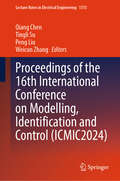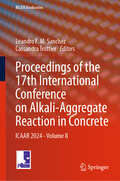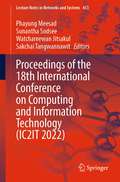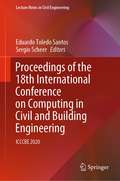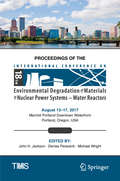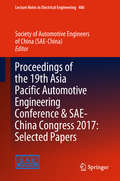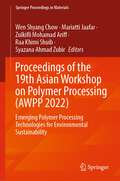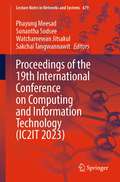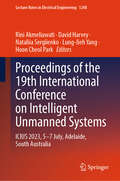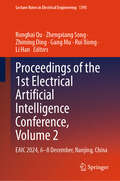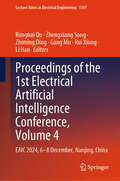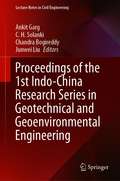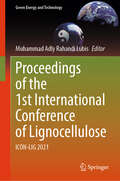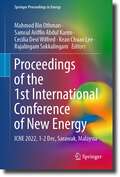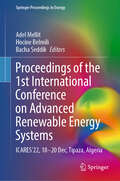- Table View
- List View
Proceedings of the 16th International Conference on Modelling, Identification and Control (Lecture Notes in Electrical Engineering #1315)
by Weicun Zhang Peng Liu Qiang Chen Tingli SuThis book includes original, peer-reviewed research papers from the 16th International Conference on Modelling, Identification and Control (ICMIC2024), held in Datong, Shanxi, China on Aug.9-11, 2024. The topics covered include but are not limited to: System Identification, Linear/Nonlinear Control Systems, Data-driven Modelling and Control, Process Modelling and Process Control, Fault Diagnosis and Reliable Control, Intelligent Systems, and Machine Learning and Artificial Intelligence. The papers showcased here share the latest findings on methodologies, algorithms and applications in modelling, identification, and control, integrated with Artificial Intelligence (AI), making the book an asset for researchers, engineers, and university students alike.
Proceedings of the 17th International Conference on Alkali-Aggregate Reaction in Concrete: ICAAR 2024 - Volume I (RILEM Bookseries #49)
by Leandro F. M. Sanchez Cassandra TrottierThis book gathers the peer-reviewed papers presented at the 17th International Conference on Alkali-Aggregate Reaction in Concrete (ICAAR), held in Ottawa, Ontario, Canada, on May 19-24, 2024. It highlights the latest advances and innovations in the field of internal swelling reactions, particularly alkali-aggregate reaction (AAR), and combined mechanisms such as delayed ettringite formation (DEF). The conference topics encompass understanding the reaction mechanisms and the affecting factors; testing methods and preventative measures; diagnosis, evaluation, and prognosis; monitoring and NDT; structural effects and modeling at all scales; repair and remedial measures; and combined mechanisms (e.g., DEF). The contributions, which were selected by means of a rigorous international peer-review process, present a wealth of exciting ideas that will open novel research directions and foster new multidisciplinary collaborations.
Proceedings of the 17th International Conference on Alkali-Aggregate Reaction in Concrete: ICAAR 2024 - Volume II (RILEM Bookseries #50)
by Leandro F. M. Sanchez Cassandra TrottierThis book gathers the peer-reviewed papers presented at the 17th International Conference on Alkali-Aggregate Reaction in Concrete (ICAAR), held in Ottawa, Ontario, Canada, on May 19–24, 2024. It highlights the latest advances and innovations in the field of internal swelling reactions, particularly alkali-aggregate reaction (AAR), and combined mechanisms such as delayed ettringite formation (DEF). The conference topics encompass understanding the reaction mechanisms and the affecting factors; testing methods and preventative measures; diagnosis, evaluation, and prognosis; monitoring and NDT; structural effects and modeling at all scales; repair and remedial measures; and combined mechanisms (e.g., DEF). The contributions, which were selected by means of a rigorous international peer-review process, present a wealth of exciting ideas that will open novel research directions and foster new multidisciplinary collaborations.
Proceedings of the 17th International Conference on Industrial Engineering and Industrial Management (Lecture Notes on Data Engineering and Communications Technologies #206)
by Joaquín Bautista-Valhondo Manuel Mateo-Doll Amaia Lusa Rafael Pastor-MorenoThis book presents selected papers from the 17th International Conference on Industrial Engineering and Industrial Management in 2023. The Conference was promoted by ADINGOR (Asociación para el Desarrollo de la Ingeniería de Organización) and organized by the Universitat Politècnica de Catalunya, Spain, on July 6th and 7th, 2023. The book provides a comprehensive overview of contemporary research and practical applications in various domains of industry and academia. Spanning a wide array of topics, readers will delve into studies on prosocial choice replication, project risk prioritization through Monte Carlo simulation, linear representation of greenhouse gas emissions, barriers to total productive maintenance implementation, and critical examinations of emerging technologies like ChatGPT and blockchain in educational and industrial contexts. Additionally, case studies explore themes such as influencer impact on student purchasing behavior, lean manufacturing, additive manufacturing parameter definition, and the application of Benford's Law in network science. The book also delves into sustainability concerns, including last-mile delivery solutions, carbon footprint reduction in public transport, and integration of operations strategies into circular supply chains. From advanced optimization models to the role of artificial intelligence in machinery design and workforce scheduling, this compilation serves as a valuable resource for scholars, practitioners, and students alike, offering insights into the forefront of research and innovation shaping contemporary industries and academic disciplines.
Proceedings of the 18th Conference of the Associated Research Centers for the Urban Underground Space: ACUUS 2023; 1–4 November; Singapore (Lecture Notes in Civil Engineering #471)
by Wei Wu Xiaozhao Li Yingxin Zhou Chun Fai LeungThis book presents peer-reviewed articles from the 18th Conference of the Associated Research Centers for the Urban Underground Space (ACUUS 2023) held in Singapore from November 1 to 4, 2023. It highlights new opportunities and challenges in underground space use amid a re-focus on exploring and developing the underground space as a strategic resource and part of sustainable development. The new frontier presents unprecedented opportunities for simultaneously improving urban infrastructure, urban livability, and resilience. At the same time, special challenges exist in developing underground space—both from a human design perspective and in terms of complexity, 3D planning, system integration, technical, and life cycle costs. Equally important is the need to move from the creation of underground space as a haphazard, last resort solution to a well-planned, and integrated use of underground space that can serve the needs of society for future generations as well as our own. As the world emerges from the COVID-19 pandemic and is faced with the many challenges in climate resilience, the works presented in this book provide a timely opportunity and an excellent forum for engaging discussions and exchanges among planners, designers, engineers, researchers, and policy makers.
Proceedings of the 18th International Conference on Computing and Information Technology (Lecture Notes in Networks and Systems #453)
by Phayung Meesad Sunantha Sodsee Watchareewan Jitsakul Sakchai TangwannawitThis book gathers the proceedings of the 18th International Conference on Computing and Information Technology (IC2IT2022), held on May 19–20, 2022, in Kanchanaburi, Thailand. The topics covered include machine learning, natural language processing, image processing, intelligent systems and algorithms, as well as network and cloud computing. These lead to the major research directions for emerging information technology and innovation, reflecting digital trends.
Proceedings of the 18th International Conference on Computing in Civil and Building Engineering: ICCCBE 2020 (Lecture Notes in Civil Engineering #98)
by Eduardo Toledo Santos Sergio ScheerThis book gathers the latest advances, innovations, and applications in the field of information technology in civil and building engineering, presented at the 18th International Conference on Computing in Civil and Building Engineering (ICCCBE), São Paulo, Brazil, August 18-20, 2020. It covers highly diverse topics such as BIM, construction information modeling, knowledge management, GIS, GPS, laser scanning, sensors, monitoring, VR/AR, computer-aided construction, product and process modeling, big data and IoT, cooperative design, mobile computing, simulation, structural health monitoring, computer-aided structural control and analysis, ICT in geotechnical engineering, computational mechanics, asset management, maintenance, urban planning, facility management, and smart cities. Written by leading researchers and engineers, and selected by means of a rigorous international peer-review process, the contributions highlight numerous exciting ideas that will spur novel research directions and foster multidisciplinary collaborations.
Proceedings of the 18th International Conference on Environmental Degradation of Materials in Nuclear Power Systems – Water Reactors: Volume 2 (The Minerals, Metals & Materials Series)
by Michael Wright John H. Jackson Denise ParaventiThis two-volume set represents a collection of papers presented at the 18th International Conference on Environmental Degradation of Materials in Nuclear Power Systems – Water Reactors. The purpose of this conference series is to foster an exchange of ideas about problems and their remedies in water-cooled nuclear power plants of today and the future. Contributions cover problems facing nickel-based alloys, stainless steels, pressure vessel and piping steels, zirconium alloys, and other alloys in water environments of relevance. Components covered include pressure boundary components, reactor vessels and internals, steam generators, fuel cladding, irradiated components, fuel storage containers, and balance of plant components and systems.
Proceedings of the 18th Latin American Conference on Learning Technologies (Lecture Notes in Educational Technology)
by Santiago BerrezuetaThe proceedings of the 18th edition of Latin American Conference on Learning Technologies (LACLO) demonstrates the developments in the research of learning science, learning resources, challenges and solutions. This Proceedings book showcases a collection of quality articles that explores and discusses trending topics in education in the upcoming years. This book serves as a valuable instrument and source of information on the recent advances in educational technology
Proceedings of the 18th Symposium on Environmental Issues and Waste Management in Energy and Mineral Production: SWEMP 2018—Selected Works
by Raj Singhal Eleonora Widzyk-Capehart Asieh HekmatThe research papers presented in these proceedings volumes cover the latest developments and findings in the fields of mine health, safety, energy, waste management,reclamation and rehabilitation, mine closure and environmental protection.Authors from over 20 countries with backgrounds in chemistry, engineering, technology and management, and hailing from the government, industry and academia, have contributed to this book.The contents of this book will be of interest to scientists, engineers, consultants and government personnel who are responsible for the development and implementation of innovative approaches, techniques and technologies in the minerals industries. It will also benefit academic researchers, as it addresses the latest advances in fundamental research.
Proceedings of the 19th Asia Pacific Automotive Engineering Conference & SAE-China Congress 2017: Selected Papers (Lecture Notes in Electrical Engineering #486)
by Society ofThis Proceedings volume gathers outstanding papers submitted to the 19th Asia Pacific Automotive Engineering Conference & 2017 SAE-China Congress, the majority of which are from China – the largest car-maker as well as most dynamic car market in the world. The book covers a wide range of automotive topics, presenting the latest technical advances and approaches to help technicians solve the practical problems that most affect their daily work.
Proceedings of the 19th Asian Workshop on Polymer Processing: Emerging Polymer Processing Technologies for Environmental Sustainability (Springer Proceedings in Materials #24)
by Wen Shyang Chow Mariatti Jaafar Zulkifli Mohamad Ariff Raa Khimi Shuib Syazana Ahmad ZubirThis book presents the selected papers from the 19th Asian Workshop in Polymer Processing (AWPP 2022) highlighting the latest research breakthroughs in the field of polymeric materials and processing technologies. The topics of the conference provides an exclusive forum for intellectually stimulating and engaging interactions among academicians and industrialists to share their recent scientific breakthroughs and emerging trends in polymer processing technologies and their contributions towards environmental sustainability. Its content appeals to the researchers, academics, industry practitioners working in the field of green sustainable polymers.
Proceedings of the 19th International Conference on Computing and Information Technology (Lecture Notes in Networks and Systems #679)
by Phayung Meesad Sunantha Sodsee Watchareewan Jitsakul Sakchai TangwannawitThis book gathers the high-quality papers presented at the 19th International Conference on Computing and Information Technology (IC2IT2023), held on May 18–19, 2023, in Bangkok, Thailand. The book presents an original research work for both academic and industry domains, which is aiming to show valuable knowledge, skills and experiences in the field of computing and information technology. The topics covered in the book include natural language processing, image processing, intelligent systems and algorithms, as well as machine learning. These lead to the major research directions for innovating computational methods and applications of information technology.
Proceedings of the 19th International Conference on Intelligent Unmanned Systems: ICIUS 2023, 5–7 July, Adelaide, South Australia (Lecture Notes in Electrical Engineering #1248)
by David Harvey Lung-Jieh Yang Rini Akmeliawati Nataliia Sergiienko Hoon Cheol ParkThis book contains selected high-quality reviewed papers that have been accepted and presented at the 19th International Conference of Intelligent Unmanned Systems (ICIUS 2023), which was held in Adelaide, Australia, on 5–7 July 2023. The book is composed of articles that cover the advanced progress in unmanned systems, such as bio-inspired, underwater, aerial, and off-earth systems, as well as their subsystems, including control and navigation, communication, and machine vision systems. The book is suitable for researchers, engineers, graduates, and hobbyists who have interest in intelligent unmanned systems and their advances.
Proceedings of the 19th Latin American Conference on Learning Technologies (Lecture Notes in Educational Technology)
by Antonio Silva Sprock Vanessa Agredo-Delgado Alejandra Beatriz LliterasThis book presents the proceedings of the XIX Latin American Conference on Learning Technologies-LACLO 2024. It showcases advances in learning science research, learning resources, and challenges and solutions in various Latin American countries, bringing together and disseminating emerging innovations and studies that are transforming the educational field in this region. This book presents case studies, comparative analyses, and methodological proposals that have proven effective in diverse educational contexts. In addition, it features detailed illustrations and tables to facilitate the understanding and application of the concepts included. It serves as a valuable tool and source of information for researchers, educators, and industry professionals on recent advances in educational technologies in Latin America.
Proceedings of the 1st Conference of the European Association on Quality Control of Bridges and Structures: EUROSTRUCT 2021 (Lecture Notes in Civil Engineering #200)
by Carlo Pellegrino Flora Faleschini José C. Matos Mariano Angelo Zanini Joan R. Casas Alfred StraussThis book gathers the latest advances and innovations in the field of quality control and improvement of bridges and structures, as presented by international researchers and engineers at the 1st Conference of the European Association on Quality Control of Bridges and Structures (EUROSTRUCT 2021), held in Padua, Italy on August 29 – September 1, 2021. Contributions include a wide range of topics such as testing and advanced diagnostic techniques for damage detection; SHM and AI, IoT and machine learning for data analysis of bridges and structures; fiberoptics and smart sensors for long-term SHM; structural reliability, risk, robustness, redundancy and resilience for bridges; corrosion models, fatigue analysis and impact of hazards on infrastructure components; bridge and asset management systems, and decision-making models; Life-Cycle Analysis, retrofit and service-life extension, risk management protocols; quality control plans, sustainability and green materials.
Proceedings of the 1st Electrical Artificial Intelligence Conference, Volume 1: EAIC 2024, 6-8 December, Nanjing, China (Lecture Notes in Electrical Engineering #1394)
by Zhiming Ding Rui Xiong Gang Mu Ronghai Qu Zhengxiang Song Li HanThis open access book is the first volume of proceedings of the 1st Electrical Artificial Intelligence Conference (EAIC 2024). Artificial intelligence and low-carbon economy are two vibrant research fields in the world today. To achieve the goal of carbon neutrality not only signifies a significant transformation in the economic growth mode and a profound adjustment of energy systems but also has equally significant implications for the global economic and social transformation. In the wave of the rapid development of digital economy, artificial intelligence has become an important driving force for promoting high-quality economic and social development. In the path to the &“dual carbon&” goals, which are the &“peak carbon dioxide emissions&” goal and the &“carbon neutrality&” goal, artificial intelligence will play an important role, especially in energy conservation and carbon reduction in the electrical field, which is worthy of in-depth exploration and research. In order to promote the deep integration of the electrical engineering and artificial intelligence, successfully achieve the "dual carbon" goals, and promote green, low-carbon, and high-quality development, the China Electrotechnical Society and relevant units jointly held the 1st Electrical Artificial Intelligence Conference in Nanjing, China during the December 6–8, 2024. The conference invited well-known experts with significant influence in the fields of electrical engineering and artificial intelligence to jointly explore the application of artificial intelligence in the optimization design, fault diagnosis, intelligent control, and optimized operation of electrical equipment, promote the integration of artificial intelligence innovations and various application scenarios, and actively lead the trend of technological innovation.
Proceedings of the 1st Electrical Artificial Intelligence Conference, Volume 2: EAIC 2024, 6-8 December, Nanjing, China (Lecture Notes in Electrical Engineering #1395)
by Zhiming Ding Rui Xiong Gang Mu Ronghai Qu Zhengxiang Song Li HanThis book is the second volume of proceedings of the 1st Electrical Artificial Intelligence Conference (EAIC 2024). Artificial intelligence and low-carbon economy are two vibrant research fields in the world today. To achieve the goal of carbon neutrality not only signifies a significant transformation in the economic growth mode and a profound adjustment of energy systems but also has equally significant implications for the global economic and social transformation. In the wave of the rapid development of digital economy, artificial intelligence has become an important driving force for promoting high-quality economic and social development. In the path to the &“Dual Carbon&” goals, which are the &“Peak Carbon Dioxide Emissions&” goal and the &“Carbon Neutrality&” goal, artificial intelligence will play an important role especially in energy conservation and carbon reduction in the electrical field, which is worthy of in-depth exploration and research. In order to promote the deep integration of the electrical engineering and artificial intelligence, successfully achieve the "dual carbon" goals, and promote green, low-carbon, and high-quality development, the China Electrotechnical Society and relevant units jointly held the 1st Electrical Artificial Intelligence Conference in Nanjing, China, during the December 6–8, 2024. The conference invited well-known experts with significant influence in the fields of electrical engineering and artificial intelligence to jointly explore the application of artificial intelligence in the optimization design, fault diagnosis, intelligent control, and optimized operation of electrical equipment, promote the integration of artificial intelligence innovations and various application scenarios, and actively lead the trend of technological innovation. This book is not only a valuable summary of the new developments in the field, but also a useful guideline for the researchers, engineers, and graduate students.
Proceedings of the 1st Electrical Artificial Intelligence Conference, Volume 3: EAIC 2024, 6-8 December, Nanjing, China (Lecture Notes in Electrical Engineering #1396)
by Zhiming Ding Rui Xiong Gang Mu Ronghai Qu Zhengxiang Song Li HanThis book is the third volume of proceedings of the 1st Electrical Artificial Intelligence Conference (EAIC 2024). Artificial intelligence and low-carbon economy are two vibrant research fields in the world today. To achieve the goal of carbon neutrality not only signifies a significant transformation in the economic growth mode and a profound adjustment of energy systems but also has equally significant implications for the global economic and social transformation. In the wave of the rapid development of digital economy, artificial intelligence has become an important driving force for promoting high-quality economic and social development. In the path to the &“dual carbon&” goals, which are the &“peak carbon dioxide emissions&” goal and the &“carbon neutrality&” goal, artificial intelligence will play an important role, especially in energy conservation and carbon reduction in the electrical field, which is worthy of in-depth exploration and research. In order to promote the deep integration of the electrical engineering and artificial intelligence, successfully achieve the "dual carbon" goals, and promote green, low-carbon, and high-quality development, the China Electrotechnical Society and relevant units jointly held the 1st Electrical Artificial Intelligence Conference in Nanjing, China during the December 6–8, 2024. The conference invited well-known experts with significant influence in the fields of electrical engineering and artificial intelligence to jointly explore the application of artificial intelligence in the optimization design, fault diagnosis, intelligent control, and optimized operation of electrical equipment, promote the integration of artificial intelligence innovations and various application scenarios, and actively lead the trend of technological innovation.
Proceedings of the 1st Electrical Artificial Intelligence Conference, Volume 4: EAIC 2024, 6-8 December, Nanjing, China (Lecture Notes in Electrical Engineering #1397)
by Zhiming Ding Rui Xiong Gang Mu Ronghai Qu Zhengxiang Song Li HanThis book is the fourth volume of proceedings of the 1st Electrical Artificial Intelligence Conference (EAIC 2024). Artificial intelligence and low-carbon economy are two vibrant research fields in the world today. To achieve the goal of carbon neutrality not only signifies a significant transformation in the economic growth mode and a profound adjustment of energy systems but also has equally significant implications for the global economic and social transformation. In the wave of the rapid development of digital economy, artificial intelligence has become an important driving force for promoting high-quality economic and social development. In the path to the &“Dual Carbon&” goals, which are the &“Peak Carbon Dioxide Emissions&” goal and the &“Carbon Neutrality&” goal, artificial intelligence will play an important role especially in energy conservation and carbon reduction in the electrical field, which is worthy of in-depth exploration and research. In order to promote the deep integration of the electrical engineering and artificial intelligence, successfully achieve the "dual carbon" goals, and promote green, low-carbon, and high-quality development, the China Electrotechnical Society and relevant units jointly held the 1st Electrical Artificial Intelligence Conference in Nanjing, China during the 6th~8th December, 2024. The conference invited well-known experts with significant influence in the fields of electrical engineering and artificial intelligence to jointly explore the application of artificial intelligence in the optimization design, fault diagnosis, intelligent control, and optimized operation of electrical equipment, promote the integration of artificial intelligence innovations and various application scenarios, and actively lead the trend of technological innovation.
Proceedings of the 1st Indo-China Research Series in Geotechnical and Geoenvironmental Engineering (Lecture Notes in Civil Engineering #123)
by Ankit Garg C. H. Solanki Chandra Bogireddy Junwei LiuThis book is a compilation of selected papers from the 1st Indo-China Research Series in Geotechnical and Geoenvironmental Engineering held in May 2020 online. The webinar series was held at a time of COVID-19 pandemic, when there is lack of physical connectivity. The cutting-edge research topics in Civil and Environmental Engineering ranging from bio-geotechnology, methane gas hydrates, frozen soils, rock testing, and related high-rise buildings response under wind loading will be covered. The contents make valuable contributions to academic researchers and engineers in the industry and provide a platform for demonstrating joint research between scientists from India and China. These are the first proceedings of its kind to demonstrate and motivate more joint research cooperation in Civil and Environmental Engineering between two countries. It was done mainly to motivate youth research scholars to understand each other and develop long-term cooperation.
Proceedings of the 1st International Conference of Lignocellulose: ICON-LIG 2021 (Green Energy and Technology)
by Muhammad Adly Rahandi LubisThis book presents the selected papers from the 1st International Conference of Lignocellulose, held as a virtual conference in Bogor, Indonesia, on September 13—14, 2021. The papers include contributions from researchers, scientists, academia, and practitioners covering topics from the field of biomass conversion, bio-based smart materials, forest, and environment, enhancing mitigation for climate change, radar and atmospheric science, and socio-economy in sustainable development goals. This event was organized by Japan Society for the Promotion of Science (JSPS) Alumni Association of Indonesia in collaboration with Research Center for Biomaterials, Indonesian Institute of Sciences, Indonesia.
Proceedings of the 1st International Conference of New Energy: ICNE 2022, 1-2 Dec, Sarawak, Malaysia (Springer Proceedings in Energy)
by Samsul Ariffin Abdul Karim Mahmod Bin Othman Cecilia Devi Wilfred Kean Chuan Lee Rajalingam SokkalingamThis book presents peer-reviewed articles from the 1st International Conference on New Energy (ICNE 2022), held on 1–2 December at Sarawak in Malaysia. This book highlights the current trends/studies on fundamental of hydrogen technologies and the application of hydrogen as the new sustainable renewable energy. Topics included but not limited to are: hydrogen production, its storage and transportation, and hydrogen utilization. This book contributes in making green hydrogen competitive and ready for a scale up in the 2030s, towards the objective of reaching net zero emissions by 2050
Proceedings of the 1st International Conference on Advanced Renewable Energy Systems: ICARES’22, 18–20 Dec, Tipaza, Algeria (Springer Proceedings in Energy)
by Adel Mellit Hocine Belmili Bacha SeddikThis book presents peer-reviewed articles from the First International Conference on Advanced Renewable Energy Systems (ICARES’22) held in Tipaza, Algeria. It includes recent advances and issues related to the field of renewable energy systems. It focuses on the advances in renewable energy systems, its applications, and new concepts. It brings together researchers, engineers, manufacturers, and students from all over the world to share and discuss recent advancements and developments in renewable energy research and applications.
Proceedings of the 1st International Conference on Advances in Aerospace and Navigation Systems - 2024 (Advances in Science, Technology & Innovation)
by R. Mukesh D. Venkata Ratnam P. Theerthamalai Prince Raj Lawrence RajThis book contributes to the advancement of aerospace technology and the optimization of navigation systems, thereby fostering innovation and progress in the field. The "Proceedings of the 1st International Conference on Advances in Aerospace and Navigation Systems 2024" captures a comprehensive exploration of groundbreaking research and advancements in the fields of Aerospace and Navigation. Encompassing Aerodynamics, Propulsion, Structures, Navigation, Communication, and Artificial Intelligence, these proceedings investigate the details of each domain, providing readers with a thorough understanding of the latest developments and methodologies. One of the distinguishing features of this book is its international perspective. With contributions from esteemed experts hailing from different corners of the globe, these proceedings foster a global dialogue, facilitating cross-cultural insights and collaboration. Through planetary talks and keynote addresses, readers gain access to the wisdom and expertise of renowned speakers, enhancing their comprehension of critical topics shaping the future of aerospace and navigation systems. The conference proceedings offer a platform for in-depth exploration and analysis, addressing many of the themes such as aerodynamic design, propulsion systems, structures, navigation techniques, communication systems, and the integration of artificial intelligence in aerospace applications. Furthermore, these proceedings serve as a repository of state-of-the-art research, providing readers with access to cutting-edge studies and innovative approaches. This book offers a wealth of knowledge and insights for scholars, practitioners, and students alike. In addition to its academic significance, these proceedings hold practical relevance for industry professionals and policymakers. In summary, the "Proceedings of the 1st International Conference on Advances in Aerospace and Navigation Systems 2024" stands as a testament to the collective efforts of the global aerospace community. With its comprehensive coverage, international perspective, and commitment to excellence, this book promises to be an invaluable resource for anyone invested in the future of aerospace and navigation technology.
